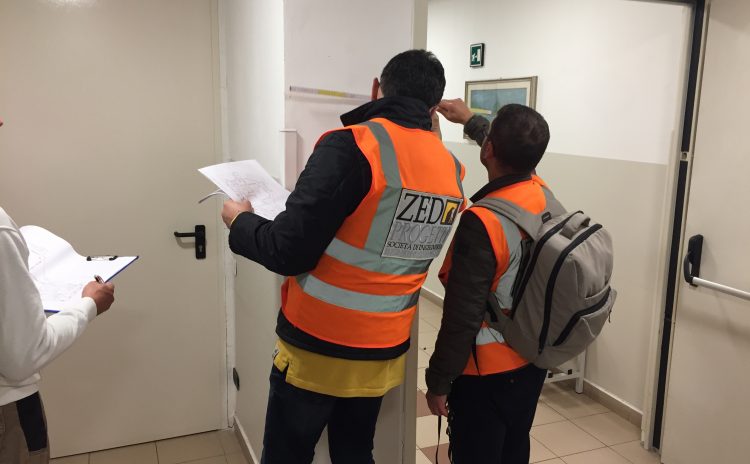L’Ordinanza n. 3274 del 20 marzo 2003 e l’obbligo della verifica di vulnerabilità per edifici strategici e rilevanti
Ordinance no. 3274 of 20 March 2003 and the obligation to check vulnerability for strategic and relevant buildings
- 10 Nov 2019

L’Ordinanza P.C.M. n. 3274 del 20 marzo 2003 (art. 2 comma 3) ha istituito l’obbligo per i proprietari, pubblici e privati, di effettuare le verifiche tecniche delle opere (edifici e opere infrastrutturali) esistenti di interesse strategico (equivalente a classe d’uso IV – par. 2.4.2. delle NTC 2018 – DM17/01/2018) o rilevanti (equivalente a classe d’uso III – par. 2.4.2. delle NTC 2018 – DM17/01/2018) in relazione alle conseguenze di un eventuale collasso.
Ai sensi del comma 5 dell’art. 2 della stessa O.P.C.M. 3274, l’obbligo non sussiste nel caso di opere progettate secondo norme vigenti successivamente al 1984, eccetto quelle situate in Comuni la cui attuale classificazione sismica risulti più severa rispetto a quella dell’epoca di realizzazione.
Il termine per l’effettuazione delle verifiche tecniche (di cui all’art. 20 comma 5 del Decreto Legge n. 248 del 31 dicembre 2007 convertito con modificazioni dalla Legge 28 febbraio 2008 n. 31) è stato prorogato al 31 marzo 2013, con Legge del 24 dicembre 2012 n. 228.
Essendo scaduto tale termine, viene altresì assunto che la priorità di verifica inizialmente riferita alle zone 1 e 2 (comma 3 art.2) sia ora estesa a qualsiasi zona sismica (ovvero anche 3 e 4).
La verifica è obbligatoria, mentre non lo è l’intervento, salvo nel caso in cui il proprietario o il gestore disponga di risorse ordinarie sufficienti per la sua esecuzione, così come esplicitato al comma 6 del medesimo art. 2 dell’O.P.C.M. 3274/03 e nella Circolare sullo stato delle verifiche sismiche DPC/SISM/0031471 del 21/04/2010. Inoltre la Presidenza del Consiglio dei Ministri – Dipartimento di Protezione Civile con nota protocollo DPC/SISM/0083283 del 4/11/2010 ha fornito chiarimenti in merito alla gestione delle verifiche condotte.
La verifica sismica deve essere condotta secondo la Normativa Tecnica sulle Costruzioni vigente e la relativa Scheda di sintesi deve essere redatta secondo quanto previsto nell’OPCM 3274/2003.
L’elenco delle opere strategiche e rilevanti può essere consultato:
- per parte statale, sul Decreto n. 3685 del Capo del Dipartimento della Protezione Civile del 21 ottobre 2003
- per la parte regionale, nella relativa normativa concorrente.
Quindi in sintesi i passi da seguire per stabilire se un immobile (complesso immobiliare) deve essere soggetto a verifica di vulnerabilità sismica sono i seguenti:
- Non è necessario individuare la zona sismica in quanto ora vale per tutte
- Verificare se il fabbricato rientri o meno nella definizione di edificio di interesse strategico (classe IV) oppure rilevante (classe III) controllando nella normativa della Regione di appartenenza
- Verificare se l’immobile (ovvero, se realizzato in più parti successive, quella più antica) è stato costruito successivamente al 1984 e se la classificazione sismica del Comune di appartenenza non sia cambiata rispetto a quella vigente al tempo della realizzazione, per cui:
a. Nel caso in cui l’epoca di costruzione sia successiva al 1984 e la classificazione non sia diventata più severa, la verifica di vulnerabilità sismica non è obbligatoria
b. Nel caso in cui l’epoca di costruzione sia precedente al 1984 oppure sia successiva ma ci sia stato un aggravamento della classificazione, la verifica è obbligatoria.
Ed una volta eseguita la verifica di vulnerabilità sismica?
Di fatto non c’è l’obbligo di miglioramento sismico.
Ma nel caso si volesse migliorare (ai sensi par. 8.4.2 delle NTC 2018 – DM 17/01/2018):
- Se la costruzione è strategica (classe IV) si deve almeno raggiungere il 60% del livello di sicurezza rispetto alla norma attuale
- Se la costruzione è rilevante (classe III) e ad uso scolastico si deve almeno raggiungere il 60% del livello di sicurezza rispetto alla norma attuale
- Se la costruzione è rilevante (classe III) ma non ad uso scolastico si deve almeno raggiungere il 10% in più del livello di sicurezza rispetto a quello rilevato dalla verifica di vulnerabilità sismica.
- Se gli interventi di miglioramento prevedono l’utilizzo di sistemi di isolamento si deve raggiungere il 100%
Premesso che la Normativa in Italia tende ad essere caotica, confusa e sovrapposta, bisogna considerare che esiste però una Normativa, anche se antecedente alle NTC 2018, che individua come limite minimo di sicurezza da raggiungere il 60% (OPCM N. 3907/2010 art. 9 comma 4, L. 122/2012 art. 3 comma 10). Pertanto, in termini cautelativi rispetto ad una eventuale situazione di contenzioso giudiziale è opportuno attenersi al 60% come livello minimo da raggiungere comunque in un miglioramento.
Ad esempio nel caso di una ipotetica RSA (Residenza Sanitaria Assistenziale) in Piemonte in base alla normativa Regione Piemonte (DGR n. 64-11402 del 23/12/2003) essa risulta essere definita come rilevante (punto e – Strutture sanitarie e/o socioassistenziali con ospiti non autosufficienti – ospizi, orfanotrofi, ecc.), e quindi di classe d’uso III non scolastico. Se fosse stata costruita anteriormente al 1984 oppure successivamente ma ci fosse stato un aggravamento della classificazione della zona sismica, la verifica è obbligatoria.
Se poi, ad esempio, il livello di sicurezza rilevato tramite verifica di vulnerabilità fosse del 20% e si volesse migliorarla, il livello minimo di sicurezza da raggiungere dovrebbe dunque essere comunque pari almeno al 60% rispetto alla normativa vigente.
 Ing. Paolo Croce- ZED PROGETTI srl
Ing. Paolo Croce- ZED PROGETTI srl
The P.C.M. Ordinance no. 3274 of 20 March 2003 (art. 2 paragraph 3) established the obligation for public and private owners to carry out technical checks on existing works (buildings and infrastructure works) of strategic interest (equivalent to use class IV – paragraph 2.4.2. of the NTC 2018 – DM17/01/2018 ) or relevant (equivalent to use class III – paragraph 2.4.2. of the NTC 2018 – DM17/01/2018) in relation to the consequences of a possible collapse.
Pursuant to paragraph 5 of art. 2 of the same O.P.C.M. 3274, the obligation does not exist in the case of works designed according to rules in force after 1984, except those located in municipalities whose current seismic classification is more stringent than that of the time of construction.
The deadline for carrying out the technical checks (as per art. 20, paragraph 5 of Decree Law no. 248 of 31 December 2007, converted with amendments by Law no. 31 of 28 February 2008) was extended to 31 March 2013, by Law no. 228 of 24 December 2012.
Since this deadline has expired, it is also assumed that the priority of verification initially referred to zones 1 and 2 (paragraph 3 art.2) is now extended to any seismic zone (or even 3 and 4).
Verification is mandatory, while intervention is not, unless the owner or manager has sufficient ordinary resources for its execution, as explained in paragraph 6 of the same art. 2 of the O.P.C.M. 3274/03 and in the Circular on the status of seismic inspections DPC/SISM/0031471 of 21/04/2010. In addition, the Presidency of the Council of Ministers – Civil Protection Department with note protocol DPC/SISM/0083283 of 4/11/2010 has provided clarification on the management of the audits conducted.
The seismic verification must be carried out in accordance with the Technical Regulations on Construction in force and the relative summary sheet must be drawn up in accordance with the provisions of OPCM 3274/2003.
The list of strategic and relevant works can be consulted:
– on the state side, on Decree no. 3685 of the Head of the Civil Protection Department of 21 October 2003
– for the regional part, in the relevant competing legislation.
Therefore, in summary, the steps to be followed to establish whether a property (property complex) should be subject to seismic vulnerability testing are as follows:
1. It is not necessary to identify the seismic zone as it now applies to all
2. Check whether or not the building falls within the definition of building of strategic interest (class IV) or relevant (class III) by checking the regulations of the region to which it belongs
3. Check if the building (if it was made in several successive parts, the oldest one) built after 1984 and if the seismic classification of the municipality has not changed compared to that in force at the time of construction, so:
a. If the time of construction is after 1984 and the classification has not become more severe, the verification of seismic vulnerability is not mandatory.
b. If the time of construction is prior to 1984 or later but there has been a deterioration in the classification, verification is mandatory.And once the verification of seismic vulnerability has been carried out?
In fact, there is no obligation for seismic improvement.
But if you want to improve (according to par. 8.4.2 of NTC 2018 – DM17/01/2018):
1 – If the construction is strategic (class IV), at least 60% of the safety level must be reached compared to the current standard.
2 – If the construction is relevant (class III) and for school use, at least 60% of the safety level must be reached compared to the current standard.
3 – If the construction is relevant (class III) but not for school use, at least 10% more of the security level must be reached than that detected by the seismic vulnerability test.
4 – If the improvement work involves the use of base isolation systems, it must be achieved 100%.
Considering that the legislation in Italy tends to be chaotic, confused and overlapping, it must be considered that there is, however, a regulation, even if prior to the NTC 2018, which identifies 60% as a minimum safety limit to be achieved (OPCM N. 3907/2010 art. 9 paragraph 4, L. 122/2012 art. 3 paragraph 10). Therefore, in precautionary terms with respect to a possible situation of litigation is appropriate to stick to 60% as the minimum level to be achieved in any case in an improvement.
For example, in the case of a hypothetical RSA (Residenza Sanitaria Assistenziale) in Piedmont on the basis of the Piedmont Region legislation (DGR no. 64-11402 of 23/12/2003) it is defined as relevant (point e – Health and/or social welfare facilities with non-self-sufficient guests – hospices, orphanages, etc..), and therefore class III use non-school. If it was built before 1984 or later but there has been a worsening of the classification of the seismic zone, verification is mandatory. If, for example, the level of security detected by the vulnerability check was 20% and the intention was to improve it, the minimum level of security to be achieved should therefore be at least 60% compared to the regulations in force.

